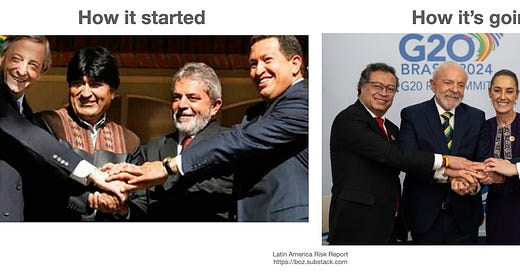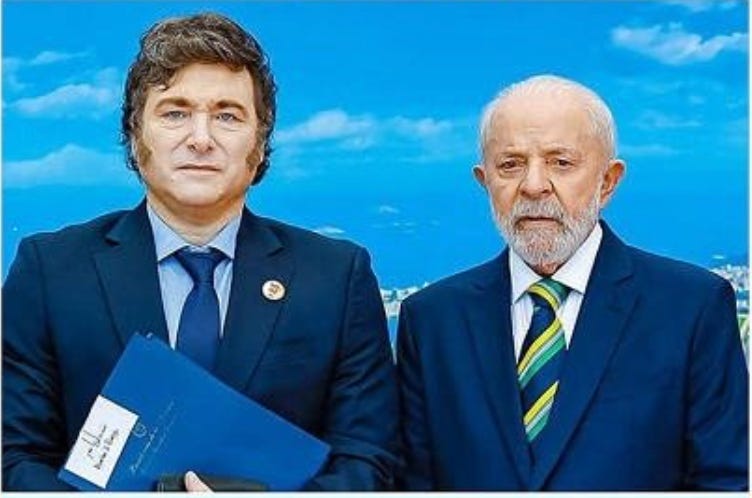Two photos of Latin America's left, 19 years apart
The legacy of the leftwing vision from 2005 does not look great today
Chilean President Gabriel Boric published a photo with Lula, Sheinbuam and Petro to his Twitter feed yesterday with the message, “Con solidaridad entre nuestros pueblos, avanzamos por una América Latina unida!”
Boric was 19 years old when the photo on the left was taken. The photo of Lula smiling with Nestor Kirchner, Hugo Chavez, and a not-yet-elected Evo Morales occurred on the sidelines of the 2005 Summit of the Americas in Mar del Plata, Argentina. It was the moment that the Pink Tide made its presence felt. With President George W. Bush just miles away, Hugo Chavez gathered allies and led a huge rally to declare the dream of a Free Trade Agreement in the Americas dead.
But Latin American unity as defined by the leftwing leaders was fleeting. UNASUR is essentially dead as an organization. CELAC meets once per year for a presidential photo-op but otherwise doesn’t do anything. ALBA, set up in 2004 by Hugo Chavez, is still around though also mostly symbolic. Mercosur, started in the 1990’s as a neoliberal free trade organization but taken in a leftwing direction the following decade, continues to flounder due to the regular ideological differences of its founding members.
As Mercosur turned left, a few more conservative leaders formed the Pacific Alliance to promote free trade. Three presidents of the Pacific Alliance are in the picture of leftwing leaders taken this week at the G20. They are just missing Peru, which has a nominally leftist president who just inaugurated a giant Chinese-controlled megaport that could be great for regional trade. Yet, that organization has also fallen on hard times and disputes that prevent it from prospering.
The photos above aren’t just about the formal structures of Latin American unity, but also about the ideals vs reality that Latin American leftist ideology faced over the past two decades. Of the men on the left, only Lula arguably succeeded (and that is debatable). He served two terms and remained popular as he handed the presidency to his chosen democratically elected successor. A drawn-out recession, Dilma’s impeachment and Bolsonaro’s chaos followed, but now Lula is back in office and implementing his policies once more.
After Nestor Kirchner, Argentina faced more economic crashes and now has a leader in office who defines everything those men on the left hated. Evo Morales consolidated power and held on until he was forced out. Evo managed to get a successor into office but is now leading a quasi-insurgency against that successor. Hugo Chavez set the stage with his policies but died before the country was hit by one of the worst economic collapses in history, a wave of migration in which a quarter of the population fled the country, and the most repressive dictatorship in South America since the dirty wars of the 1970’s.
Regarding the more modern photo, Boric and Petro are both struggling and will likely be replaced by politicians from very different ideologies in elections in the coming two years. Sheinbaum continues AMLO’s vision for Mexico, but the narrative being built is not one of Latin American unity. Lula is on his retirement tour with no clear successor either in Brazil or as the regional leader of the democratic left.
It’s also notable that all four countries in that G20 photo this week have made some attempt to counter the dictatorship in Venezuela but have failed to halt the stolen election, consolidation of power by Maduro, and the ongoing abuses. They refused to even discuss the Venezuela issue at the summit this week. That photo of a smiling Hugo Chavez standing next to Lula in 2005 hangs over the Pink Tide’s failures.
The ideological pendulum will continue to swing in Latin America. Twenty years from now, there will probably be a photo of Boric with three other Latin American leaders in a similar pose promising regional unity. Let’s hope in the interim that the longterm legacy of the leaders in the 2024 photo holds up better than the one from 2005.
PS: In case you need an update on Mercosur’s current status….




